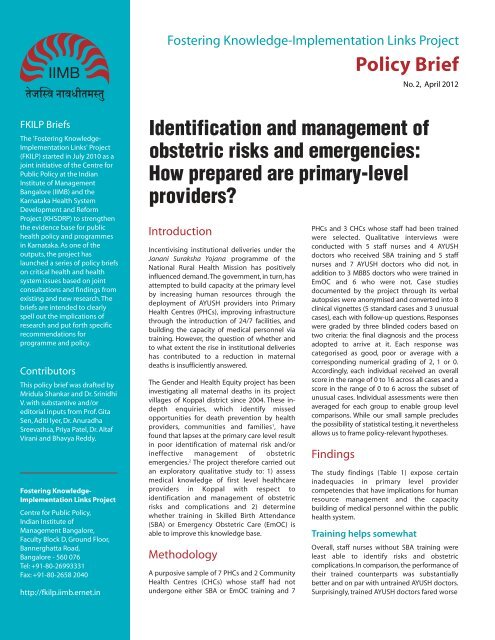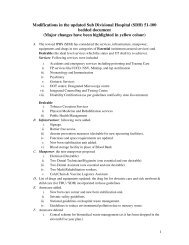Policy Brief - IIMB - Indian Institute of Management Bangalore
Policy Brief - IIMB - Indian Institute of Management Bangalore
Policy Brief - IIMB - Indian Institute of Management Bangalore
Create successful ePaper yourself
Turn your PDF publications into a flip-book with our unique Google optimized e-Paper software.
FKILP <strong>Brief</strong>s<br />
The 'Fostering Knowledge-<br />
Implementation Links' Project<br />
(FKILP) started in July 2010 as a<br />
joint initiative <strong>of</strong> the Centre for<br />
Public <strong>Policy</strong> at the <strong>Indian</strong><br />
<strong>Institute</strong> <strong>of</strong> <strong>Management</strong><br />
<strong>Bangalore</strong> (<strong>IIMB</strong>) and the<br />
Karnataka Health System<br />
Development and Reform<br />
Project (KHSDRP) to strengthen<br />
the evidence base for public<br />
health policy and programmes<br />
in Karnataka. As one <strong>of</strong> the<br />
outputs, the project has<br />
launched a series <strong>of</strong> policy briefs<br />
on critical health and health<br />
system issues based on joint<br />
consultations and findings from<br />
existing and new research. The<br />
briefs are intended to clearly<br />
spell out the implications <strong>of</strong><br />
research and put forth specific<br />
recommendations for<br />
programme and policy.<br />
Contributors<br />
This policy brief was drafted by<br />
Mridula Shankar and Dr. Srinidhi<br />
V. with substantive and/or<br />
editorial inputs from Pr<strong>of</strong>. Gita<br />
Sen, Aditi Iyer, Dr. Anuradha<br />
Sreevathsa, Priya Patel, Dr. Altaf<br />
Virani and Bhavya Reddy.<br />
Fostering Knowledge-<br />
Implementation Links Project<br />
Centre for Public <strong>Policy</strong>,<br />
<strong>Indian</strong> <strong>Institute</strong> <strong>of</strong><br />
<strong>Management</strong> <strong>Bangalore</strong>,<br />
Faculty Block D, Ground Floor,<br />
Bannerghatta Road,<br />
<strong>Bangalore</strong> - 560 076<br />
Tel: +91-80-26993331<br />
Fax: +91-80-2658 2040<br />
http://fkilp.iimb.ernet.in<br />
Fostering Knowledge-Implementation Links Project<br />
Identification and management <strong>of</strong><br />
obstetric risks and emergencies:<br />
How prepared are primary-level<br />
providers?<br />
Introduction<br />
Incentivising institutional deliveries under the<br />
Janani Suraksha Yojana programme <strong>of</strong> the<br />
National Rural Health Mission has positively<br />
influenced demand. The government, in turn, has<br />
attempted to build capacity at the primary level<br />
by increasing human resources through the<br />
deployment <strong>of</strong> AYUSH providers into Primary<br />
Health Centres (PHCs), improving infrastructure<br />
through the introduction <strong>of</strong> 24/7 facilities, and<br />
building the capacity <strong>of</strong> medical personnel via<br />
training. However, the question <strong>of</strong> whether and<br />
to what extent the rise in institutional deliveries<br />
has contributed to a reduction in maternal<br />
deaths is insufficiently answered.<br />
The Gender and Health Equity project has been<br />
investigating all maternal deaths in its project<br />
villages <strong>of</strong> Koppal district since 2004. These indepth<br />
enquiries, which identify missed<br />
opportunities for death prevention by health<br />
providers, communities and families 1 , have<br />
found that lapses at the primary care level result<br />
in poor identification <strong>of</strong> maternal risk and/or<br />
ineffective management <strong>of</strong> obstetric<br />
emergencies. 2 The project therefore carried out<br />
an exploratory qualitative study to: 1) assess<br />
medical knowledge <strong>of</strong> first level healthcare<br />
providers in Koppal with respect to<br />
identification and management <strong>of</strong> obstetric<br />
risks and complications and 2) determine<br />
whether training in Skilled Birth Attendance<br />
(SBA) or Emergency Obstetric Care (EmOC) is<br />
able to improve this knowledge base.<br />
Methodology<br />
A purposive sample <strong>of</strong> 7 PHCs and 2 Community<br />
Health Centres (CHCs) whose staff had not<br />
undergone either SBA or EmOC training and 7<br />
PHCs and 3 CHCs whose staff had been trained<br />
were selected. Qualitative interviews were<br />
conducted with 5 staff nurses and 4 AYUSH<br />
doctors who received SBA training and 5 staff<br />
nurses and 7 AYUSH doctors who did not, in<br />
addition to 3 MBBS doctors who were trained in<br />
EmOC and 6 who were not. Case studies<br />
documented by the project through its verbal<br />
autopsies were anonymised and converted into 8<br />
clinical vignettes (5 standard cases and 3 unusual<br />
cases), each with follow-up questions. Responses<br />
were graded by three blinded coders based on<br />
two criteria: the final diagnosis and the process<br />
adopted to arrive at it. Each response was<br />
categorised as good, poor or average with a<br />
corresponding numerical grading <strong>of</strong> 2, 1 or 0.<br />
Accordingly, each individual received an overall<br />
score in the range <strong>of</strong> 0 to 16 across all cases and a<br />
score in the range <strong>of</strong> 0 to 6 across the subset <strong>of</strong><br />
unusual cases. Individual assessments were then<br />
averaged for each group to enable group level<br />
comparisons. While our small sample precludes<br />
the possibility <strong>of</strong> statistical testing, it nevertheless<br />
allows us to frame policy-relevant hypotheses.<br />
Findings<br />
<strong>Policy</strong> <strong>Brief</strong><br />
The study findings (Table 1) expose certain<br />
inadequacies in primary level provider<br />
competencies that have implications for human<br />
resource management and the capacity<br />
building <strong>of</strong> medical personnel within the public<br />
health system.<br />
Training helps somewhat<br />
No. 2, April 2012<br />
Overall, staff nurses without SBA training were<br />
least able to identify risks and obstetric<br />
complications. In comparison, the performance <strong>of</strong><br />
their trained counterparts was substantially<br />
better and on par with untrained AYUSH doctors.<br />
Surprisingly, trained AYUSH doctors fared worse
Medical Cadre Unusual Cases All cases<br />
(n=3; range=0-6) (n=8; range=0-16)<br />
Staff nurses<br />
without SBA training 0.0 3.6<br />
Staff nurses<br />
with SBA training 2.2 6.6<br />
AYUSH doctors<br />
without SBA training 1.0 7.1<br />
AYUSH doctors<br />
with SBA training 0.5 5.5<br />
MBBS doctors<br />
without EmOC training 3.7 11.0<br />
MBBS doctors<br />
with EmOC training 4.7 13.7<br />
Table 1: Average group scores <strong>of</strong> responses to case vignettes<br />
than their untrained counterparts. MBBS doctors without EmOC<br />
training earned substantially higher scores than staff nurses and<br />
AYUSH doctors. Those with EmOC training fared even better.<br />
Unusual presentations <strong>of</strong> risks were poorly identified by both<br />
trained and untrained nurses and AYUSH doctors, albeit to different<br />
degrees. SBA training appears to have no positive impact in this<br />
regard. Although EmOC-trained and untrained MBBS doctors<br />
performed much better in their identification <strong>of</strong> unusual risk, they<br />
were still below the maximum score <strong>of</strong> 6.<br />
SBA training: Inadequate and ineffective?<br />
The SBA training is inadequate to build the skills required for<br />
appropriate assessment and management <strong>of</strong> obstetric risks and<br />
complications. While this training includes a module on risk that<br />
covers all the risk symptoms presented, trained AYUSH doctors and<br />
nurses were unable to identify many <strong>of</strong> these symptoms,<br />
particularly the unusual presentations relating to anaemia and<br />
pregnancy-induced hypertension. Given its exhaustive content, the<br />
duration <strong>of</strong> training (21 days) is inadequate, with only one-sixth <strong>of</strong><br />
the available time allocated to the module on risk. The quality <strong>of</strong> the<br />
training is also variable, being dependant on the competence <strong>of</strong> the<br />
trainers. Additionally, since these trainings are held in medical<br />
colleges, trainees have to compete with regular students to gain<br />
hands-on experience and exposure to cases. The absence <strong>of</strong> a<br />
thorough post-training assessment and certification system further<br />
reduces training rigour and the ability to evaluate the effectiveness<br />
<strong>of</strong> the programme in improving the competency <strong>of</strong> skilled birth<br />
attendants.<br />
Human resource allocation and management<br />
The study strongly suggests that AYUSH practitioners do not have<br />
the requisite skills to identify and handle maternal risks at the<br />
primary level. This finding is <strong>of</strong> particular relevance in districts like<br />
Koppal where 32% <strong>of</strong> the PHCs are managed by AYUSH doctors<br />
alone. 3 Their poor performance could be due to inadequacies in<br />
their basic training, the lack <strong>of</strong> supportive hands-on supervision and<br />
the absence <strong>of</strong> guidelines on their role in administering life saving<br />
allopathic treatment during emergencies. Their current level <strong>of</strong><br />
training, even when enhanced by the SBA training programme, was<br />
insufficient to enable them to be stand alone first level medical<br />
providers.<br />
2<br />
The performance <strong>of</strong> EmOC-trained MBBS doctors was notably<br />
better than their untrained counterparts. Doctors selected for this<br />
training are usually handpicked on the basis <strong>of</strong> experience and skill,<br />
and are promoted to specialist posts in first referral units on<br />
completion <strong>of</strong> the training. While such a selection and deployment<br />
process may be appropriate for human resources management, it<br />
has the paradoxical result <strong>of</strong> removing the providers best able to<br />
identify and handle maternal risk from primary level positions<br />
where these skills are urgently needed.<br />
Recommendations<br />
1.<br />
2.<br />
3.<br />
4.<br />
Improve SBA training by introducing case-based learning<br />
with greater focus on supervised hands-on training, specifically<br />
geared towards risk identification and primary management <strong>of</strong><br />
obstetric emergencies. Instituting stringent evaluation and<br />
certification criteria would also increase training rigour.<br />
Make the substantially improved SBA training mandatory<br />
for all staff nurses and AYUSH practitioners, preferably at the<br />
start <strong>of</strong> their tenure.<br />
Build the capacity <strong>of</strong> AYUSH doctors by formulating clear<br />
guidelines on the role <strong>of</strong> AYUSH practitioners as first level<br />
medical providers. A bridge course on allopathic management<br />
<strong>of</strong> emergencies and specific protocols for the administration <strong>of</strong><br />
life-saving allopathic treatments can empower AYUSH<br />
practitioners to provide essential medical care.<br />
Train first-level MBBS doctors to further strengthen their<br />
capacity to effectively screen, identify, manage and<br />
appropriately refer cases <strong>of</strong> obstetric risk and complications. A<br />
hands-on and case-based training pedagogy can serve as an<br />
effective training model.<br />
References<br />
1. Iyer A., Sen G. and Sreevathsa A. (2012). "Deciphering 'Rashomon': An<br />
approach to verbal autopsies <strong>of</strong> maternal death". (Submission under<br />
review by Global Public Health).<br />
2. Iyer A., Sen G., Sreevathsa A. and Varadan V. (2012). "Verbal autopsies <strong>of</strong><br />
maternal deaths in Koppal, Karnataka: Lessons from the grave". BMC<br />
Proceedings 2012 6(Supplement 1): P2.<br />
3. The Sukshema Project (2011). Maternal, Newborn and Child Health in<br />
Koppal District. A Situational Analysis. <strong>Bangalore</strong>: Karnataka Health<br />
Promotion Trust. Available at http://www.khpt.org/sukshema.html.<br />
[Accessed 15 April 2012]<br />
Suggested citation:<br />
Fostering Knowledge-Implementation Links Project (2012). Identification and<br />
management <strong>of</strong> obstetric risks and emergencies: How prepared are primarylevel<br />
providers? <strong>Policy</strong> <strong>Brief</strong> No. 2. <strong>Bangalore</strong>: <strong>IIMB</strong>.




